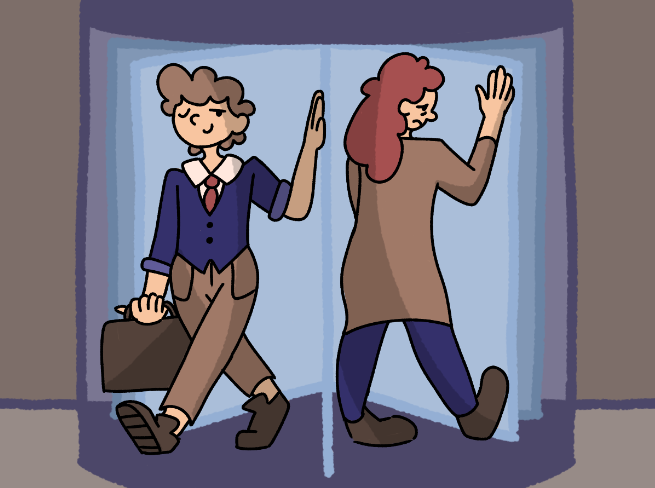[heading size=”20″ margin=”0″]Sometimes believing has nothing to do with seeing; migraines and all the suffering they cause are real [/heading]An indescribable ache creeps up the back of my spine and into my thoughts. Sometimes it’s as though little bursts of lightning shatter the ends of each nerve ending in my skull; other times I feel like every blood vessel is about to burst from the excruciating pressure. Sound sends tremors through my bones. Light feels like daggers in my eyes.
The dizziness that often accompanies the pain makes it impossible to think a complete thought or move an inch of my body. Once a migraine sets in, the best I can do is lie completely still in a dark, quiet room, thinking short, softly articulated thoughts such as “Don’t move; don’t think,” over and over again until I fall asleep and escape the pain.
More often than not, my friends and teachers don’t believe the pain I’m feeling actually exists, and even if they do believe me, they expect me to continue to function normally and just deal with it. When I tell someone I have a migraine, and I need to go home, the most popular response is for them to ask if my head actually hurts, or else they say that it’s just a headache and I’m not sick enough to leave.
A migraine is more than just a headache. Migraine headaches are neurological disorders caused by imbalances in natural brain chemistry. The imbalances in brain chemistry can arise from dilation of blood vessels, which can lead to increased levels of natural as well as pain-producing chemicals, causing the blood vessels lining the brain to swell and put pressure on nerves surrounding the vessels.
Like most brain-related fields of study, migraines are not completely understood by scientists. In my experience, if science can’t prove something intangible, then society doesn’t accept its existence. In the case of migraines, those who don’t get them either don’t believe they exist or have a limited understanding if they do.
During the past 17 years, I’ve learned the signs of an oncoming migraine. I get a sugary taste in my mouth, my head gets warm, or I’m aware I’ve done something to trigger an outburst. When I’m at home, I can take my medication, grab an ice-pack and go to sleep before it even has time to hit. No pain, no explanation needed for those around me. Outside of my home, though, I don’t have the luxury of avoiding the pain.
If I feel a migraine coming on during school, I wait to tell my teachers that I need to leave until the pain sets in. I force myself to work through my mental and physical limitations so I don’t have to miss yet another class period. When I’m with friends, too, I try to power through and get as much enjoyment as possible despite the pain.
Even though the discomfort can be debilitating, I have to choose my battles. When I’m faced with losing opportunities to excel academically or have a good time with my friends, I must decide whether I can tolerate the misery or not, and that choice can really be a pain.
By Emily Franke
Feature Photo by Caylea Erickson
Have you had a migraine? How do you cope?
The dizziness that often accompanies the pain makes it impossible to think a complete thought or move an inch of my body. Once a migraine sets in, the best I can do is lie completely still in a dark, quiet room, thinking short, softly articulated thoughts such as “Don’t move; don’t think,” over and over again until I fall asleep and escape the pain.
More often than not, my friends and teachers don’t believe the pain I’m feeling actually exists, and even if they do believe me, they expect me to continue to function normally and just deal with it. When I tell someone I have a migraine, and I need to go home, the most popular response is for them to ask if my head actually hurts, or else they say that it’s just a headache and I’m not sick enough to leave.
A migraine is more than just a headache. Migraine headaches are neurological disorders caused by imbalances in natural brain chemistry. The imbalances in brain chemistry can arise from dilation of blood vessels, which can lead to increased levels of natural as well as pain-producing chemicals, causing the blood vessels lining the brain to swell and put pressure on nerves surrounding the vessels.
Like most brain-related fields of study, migraines are not completely understood by scientists. In my experience, if science can’t prove something intangible, then society doesn’t accept its existence. In the case of migraines, those who don’t get them either don’t believe they exist or have a limited understanding if they do.
During the past 17 years, I’ve learned the signs of an oncoming migraine. I get a sugary taste in my mouth, my head gets warm, or I’m aware I’ve done something to trigger an outburst. When I’m at home, I can take my medication, grab an ice-pack and go to sleep before it even has time to hit. No pain, no explanation needed for those around me. Outside of my home, though, I don’t have the luxury of avoiding the pain.
If I feel a migraine coming on during school, I wait to tell my teachers that I need to leave until the pain sets in. I force myself to work through my mental and physical limitations so I don’t have to miss yet another class period. When I’m with friends, too, I try to power through and get as much enjoyment as possible despite the pain.
Even though the discomfort can be debilitating, I have to choose my battles. When I’m faced with losing opportunities to excel academically or have a good time with my friends, I must decide whether I can tolerate the misery or not, and that choice can really be a pain.
By Emily Franke
Feature Photo by Caylea Erickson
Have you had a migraine? How do you cope?

















































































Abby Kempf • Nov 12, 2014 at 3:07 pm
Emily, your language is so lovely!
Nikol Slatinska • Nov 10, 2014 at 8:39 pm
This story has great description, especially in the beginning. I felt like I knew what a migraine feels like, even though I’ve never had one.